Фрегати класу «Ван Спейк»
Основна інформація
Головні розміри
Машина
As built
- 2 * geared steam turbines22,370 kW (30,000 shp)
- 2 * shafts
Rebuild
- Caterpillar diesels (5 ships)
- SEMT-Pielstick diesels (1 ship)
Персонал
Бойові сили та засоби
- Radar: LW-03, DA-02, M45, M44
- Sonar: Types 170B, 162
- Combat system: SEWACO V
- 1 * OTO-Melara 76 mm gun
- 2 * twin SimbadLauncher for Mistral SAMs
- 4 * SS-N-26 SSM (On at least one ship) (Indonesian Navy)
- 4 * C-802 SSM (On five ships) (Indonesian Navy)
- 2 * 3 – Mk 32 anti submarine torpedo tubes
- 1 * NBO-105C helicopter
- Hangar
The Van Speijk-class frigates were built for the Royal Netherlands Navy in the 1960s. They were versions of the British Leander-class frigates with Dutch radars. The British design was chosen in order to enable rapid construction in order to replace elderly destroyer escorts and take up part of the NATO patrol duties of the decommissioned anti-submarine warfare carrier Karel Doorman. The ships were modernised in the late 1970s. All six ships were sold to the Indonesian Navy in 1986–89 and are still in service (as of 2014) as the Ahmad Yani-class frigates.
All ships were named after Dutch naval officers. When sold to Indonesia, they were named after Indonesian Armed Forces heroes.
Dutch modifications of original Leander-class frigates
For the most part the Dutch limited their changes to the Leander design to a wholesale replacement of the original British electronics and electrical equipment by those from Dutch manufacturers. Hollandse Signaalapparaten supplied the entire electronics suite. Specifically their LW-02 long-range air-surveillance radar, the DA-02 medium-range air/surface search radar and the M45 combined radar and optical fire control system for the 4.5 in (110 mm) guns. The Dutch HSA M44 radar/visual director for the Seacat anti-aircraft missiles could automatically target in elevation and bearing and allowed the single Seacat launcher on the British ships to be increased to two launchers on the Dutch ships, each with their own director.
Mid-life modernization
Beginning in December 1976 each of the Dutch ships was given a mid-life modernization that took about two years to finish. The twin 4.5-inch turret was replaced by a single Otobreda 76 mm gun and two quadruple mounts for Harpoon anti-ship missiles were fitted abaft of the funnel. The Mk 10 Limbo ASW mortar was replaced by a pair of triple Mk 32 torpedo launchers, one mount on each side of the hangar, and its mount plated over so the flight deck could be increased to allow the ship to carry the larger Westland Lynx helicopter in lieu of the Wasp carried earlier. The removal of the variable-depth sonar from the quarterdeck to the interior of the stern also allowed more room for the flight deck.
The electronics were also upgraded, the LW-02 radar was exchanged for a LW-03 and the DA-02 was replaced by a DA-05 radar. Most importantly an automated combat management system, SEWACO V, was fitted to aid the ship's captain in decision making. Its power plant was also extensively automated. All told these changes allowed the crew to decrease in size from 254 to about 175 which allowed greatly increased standards of habitability.
- Коментарі
 uk
uk en
en ru
ru
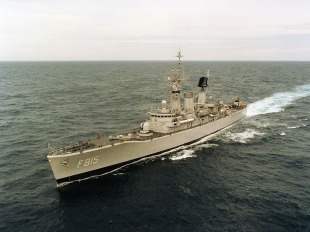
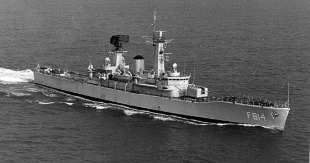
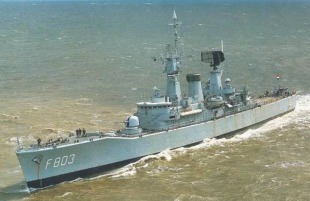
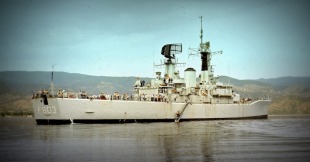
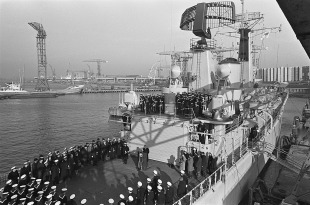
 Королівські військово-морські сили Нідерландів (Koninklijke Marine)
Королівські військово-морські сили Нідерландів (Koninklijke Marine) Військово-морські сили Індонезії
Військово-морські сили Індонезії